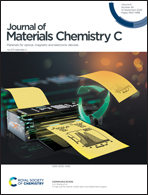Sulforhodamine B-LDH composite as a rare-earth-free red-emitting phosphor for LED lighting†
Abstract
Domestic lighting using white light-emitting diodes (WLEDs) requires a choice of materials to be eco-friendly as well as economically viable. Revisiting the optical properties of sulforhodamine B (SRB) with a new focus – designing rare-earth-free phosphors – is found here to be highly promising. Relying on a Layered Double Hydroxide (LDH) host, the dye molecules are stabilized, and the inorganic–organic assembly formed is dispersed into silicone. Homogeneous composite films present suitable and stable photometric parameters, making them appropriate candidates to replace red-emitting phosphors based on rare-earth elements.



 Please wait while we load your content...
Please wait while we load your content...